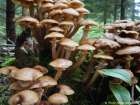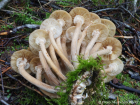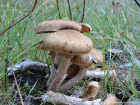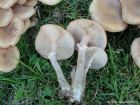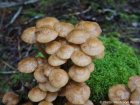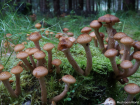Cap convex at first but becoming flattened, often with a central raised umbo, later becoming somewhat dish-shaped. The margins are often arched at maturity and the surface is sticky when wet. The cap colour is honey-yellow when young and fresh, but soon fading to yellowish or brownish, with a darker area near the centre. Fine scales cover the young caps, most noticeably towards the centre. These scales do not always remain evident as the caps reach maturity. The flesh is white, thin and firm. Gills at first white, sometimes becoming pinkish-yellow or discoloured with age, broad and fairly distant, attached to the stipe at right angles or are slightly decurrent, crowded. Stem at first whitish, becoming yellowish or reddish-brown, more or less equal or tapering towards the base, finely wholly. The ring is yellowish, cottony or woolly, superior and fairly persistent. Spore print white.
Microscopic Features: The spores are ellipsoidal, smooth, and have an apiculus. They measure 7-9 x 5-6μm and are hyaline with droplets. The spores are inamyloid.
Armillaria mellea on the First Nature Web site.
Armillaria mellea on the MushroomExpert.Com Web site.
Many mushrooms are poisonous, and some can be lethally toxic. Distinguishing between edible and poisonous mushrooms can be very challenging. Therefore, we strongly advise against consuming wild mushrooms. This website does not contain any information about the edibility or toxicity of mushrooms.
Although efforts have been made to ensure accuracy on this website, the information may contain errors and omissions. Therefore, all content provided is for educational and informational purposes only and should not be relied upon or used as a basis for consuming any plants or mushrooms.
External links are provided for reference only. We do not endorse or take responsibility for the content, advice, or products found on these sites or in any advertisements shown on this website.
